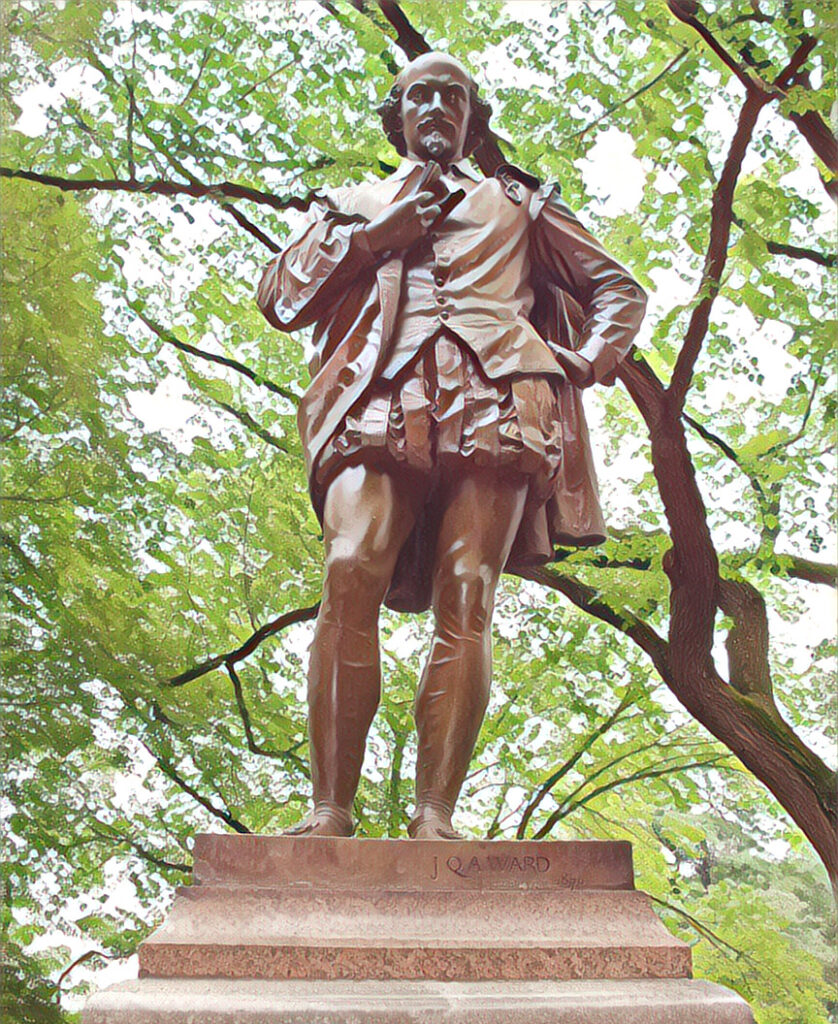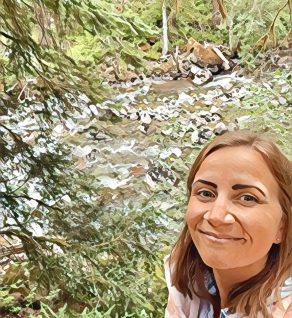As we approach the 460th year of his birth, William Shakespeare (and the idea of him) still burns bright. And as it turns out, there are loads of places to find William Shakespeare in America from coast to coast. Dozens of theater companies and festivals dazzle fans with incredible Elizabethan performances. There are busts of his tucked into nooks and crannies all over the U.S. Though there are some memorials and impressions of the Bard that stick out more than others. Here are what we think deserve top ranking.
8 BEST PLACES TO FIND WILLIAM SHAKESPEARE IN AMERICA
Shakespeare in Central Park
New York, NY
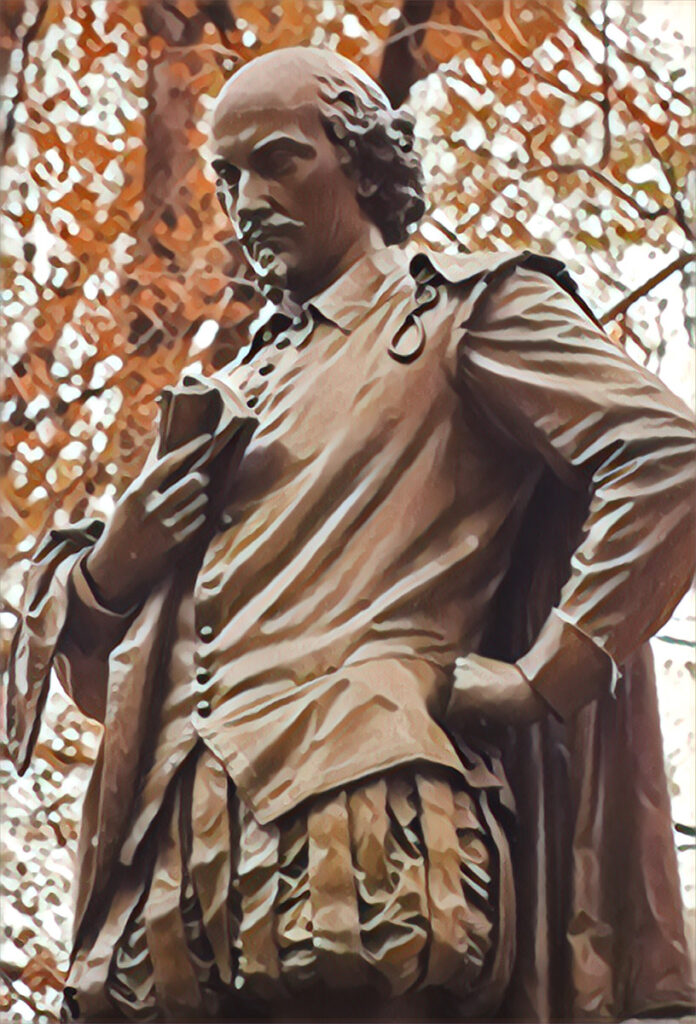
A statue of William Shakespeare greets you just beyond the Olmstead Garden on the southern side of the Mall and Literary Walk in Central Park. In 1864, a group of theater managers and actors got together to hold a contest to create a statue of Shakespeare in honor of the tricentennial of his birth.
One of these actors was the famed Edwin Booth–brother to soon-to-be assassin John Wilkes Booth. The winner of the contest was John Quincy Adams Ward who has many other notable works including the statue of George Washington in front of Federal Hall in New York City, the James A. Garfield memorial on the west side of the U.S. Capitol in Washington, DC, and the Ether Monument in the Boston Public Garden among many more.
The cornerstone for the Shakespeare statue was laid in 1864 and the statue was unveiled in 1872. Over 100 years later, in 1986, a replica cast was made for the Carolyn Blount Theatre in Montgomery, Alabama which is home to the Alabama Shakespeare Festival.
Located just below the Belvedere Castle on the west side of Central Park at 79th Street sits the cozy Shakespeare Garden. Originally dedicated on April 23, 1916 for the tricentennial of his death, the garden moved slightly in 1934 to its present day location. Spread out over three acres, the garden features hundreds of plants and flowers that Shakespeare referenced in his plays and writings, many of which attract numerous butterflies and pollinators.
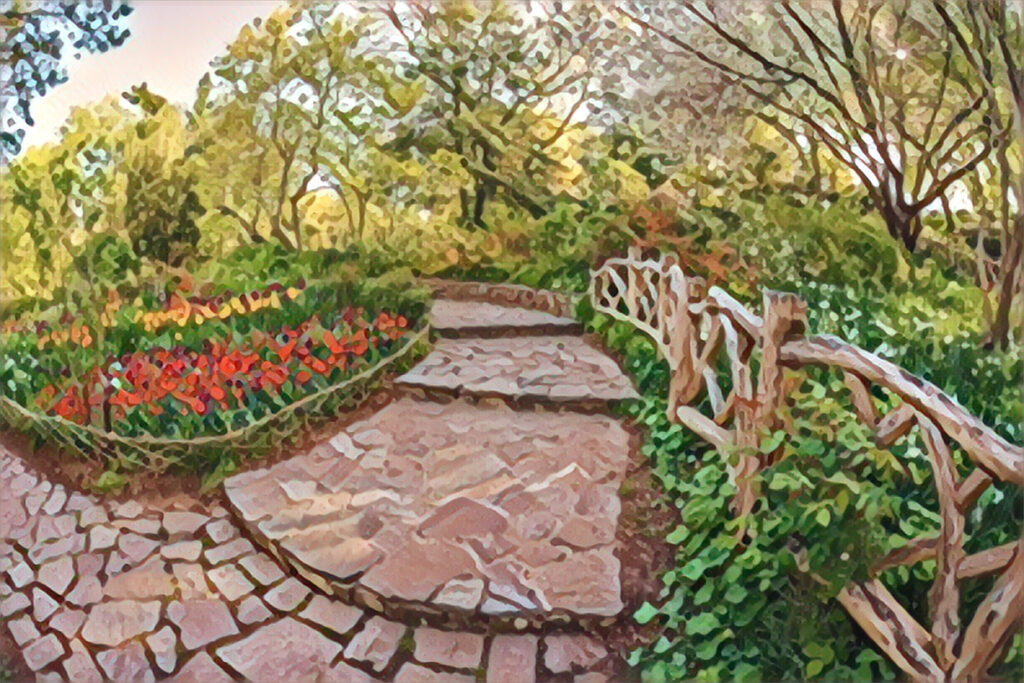
Scattered throughout the garden are ten small bronze plaques highlighting Shakespearean quotes mentioning horticultural elements. Another favorite spot is the Charles B. Stover (Parks Commissioner for NYC from 1910-1913) bench. A sleek curved design, this bench sits at a high point in the garden.
It’s also one of those whisper tricksters–sit on one side of the bench and whisper something to someone seated all the way on the other side–they will hear you. It’s magic. And physics. For children, the garden offers a downloadable discovery journal for your visit.
Not far from the Shakespeare Garden along the shore of Turtle Pond is the Delacorte Theater which features the annual Shakespeare in the Park plays each summer. It all began in 1957 when a theater producer named Joseph Papp took his Shakespeare Workshop around to different parks in the city to perform plays.
A permanent home was created in 1962 with funding from magazine publisher and philanthropist George Delacorte (he also donated money for the Delacorte Clock in Central Park Zoo, the Alice in Wonderland Statue, and nearby Shakespearean statues Romeo and Juliet and The Tempest). The first performance in the new theater was The Merchant of Venice starring James Earl Jones and George C. Scott.
The summer productions are free and highly sought after. Tickets are available daily through an online lottery and are distributed each day in person as well. The Delacorte Theater is located at 81 Central Park West, New York, NY 10024.
Folger Shakespeare Library
Washington, DC
(CLOSED FOR RENOVATION THROUGH SPRING 2024)
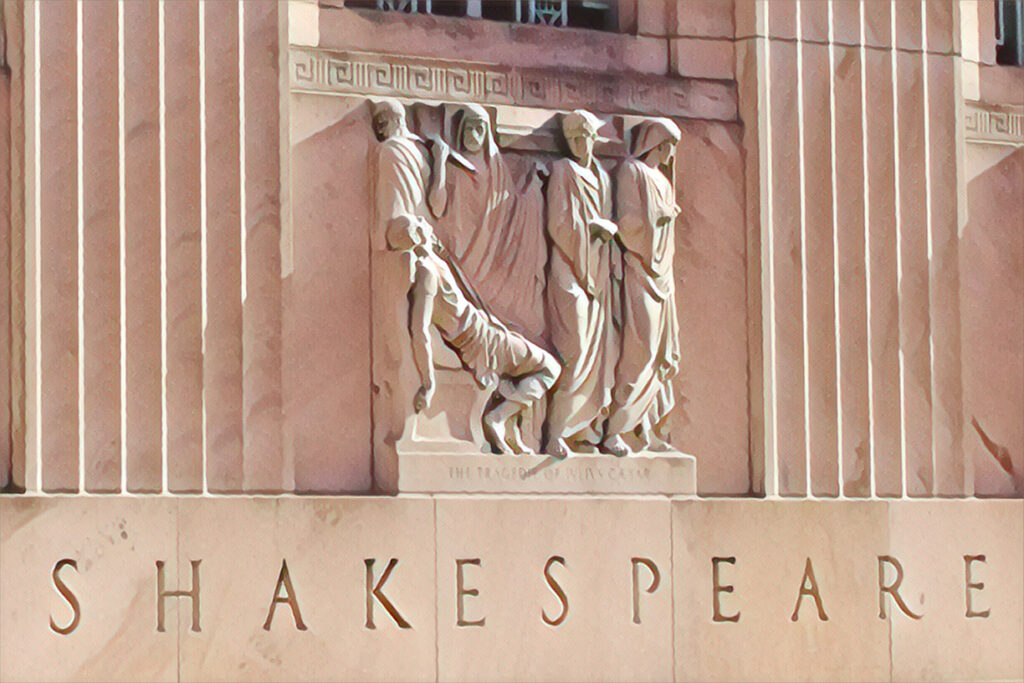
With all of the amazing sights and museums to visit in Washington, DC, you can imagine that the world’s largest Shakespeare collection could be easily overlooked. But a block to the east of the U.S. Capitol building resides a utopia for anyone wanting to enter the world of Shakespeare.
Henry Clay Folger was President and later Chairman of the Standard Oil Company in New York (he was also the nephew of J.A. Folger, who founded Folger Coffee). His Shakespeareana collection began in 1889 with a purchase of a copy of Fourth Folio of Shakespeare’s plays dating to 1685.
Along with his wife, Emily Jordan Folger (her father served as Solicitor of the Treasury Department under Presidents Abraham Lincoln and Andrew Johnson), Folger chose to open a Shakespeare Library for the American people with a collection that had amassed nearly 200,000 items by the time the library opened in 1932. Sadly, Henry Clay Folger died shortly after the cornerstone of the building was laid in 1930.
The Folger Library now holds 82 copies of the First Folio (out of the 235 copies that are known to survive), one of the two complete copies of the 1619 False Folio, and over 200 quartos of Shakespeare’s plays.
Additionally, Folger’s collection includes more Elizabeth I materials than anywhere else in North America, manuscripts of Walt Whitman and Mark Twain, numerous artworks, a Shakespearean costume worn by Edwin Booth, and much more. Don’t miss the great hall, the reading room, and try to catch a play in the Elizabethan theater.
The building is currently undergoing a major renovation to expand exhibit space and to add more accessibility, public spaces, and gardens. When it reopens in the spring of 2024 you can enjoy all of the wonders of Shakespeare. Until then, the library is offering a variety of online activities.
The Folger Shakespeare Library is located at 201 E Capitol Street SE, Washington, DC 20003. When open, it is free to visit.
Shakespeare Representing Literature
Carnegie Museum of Natural History
Pittsburgh, PA
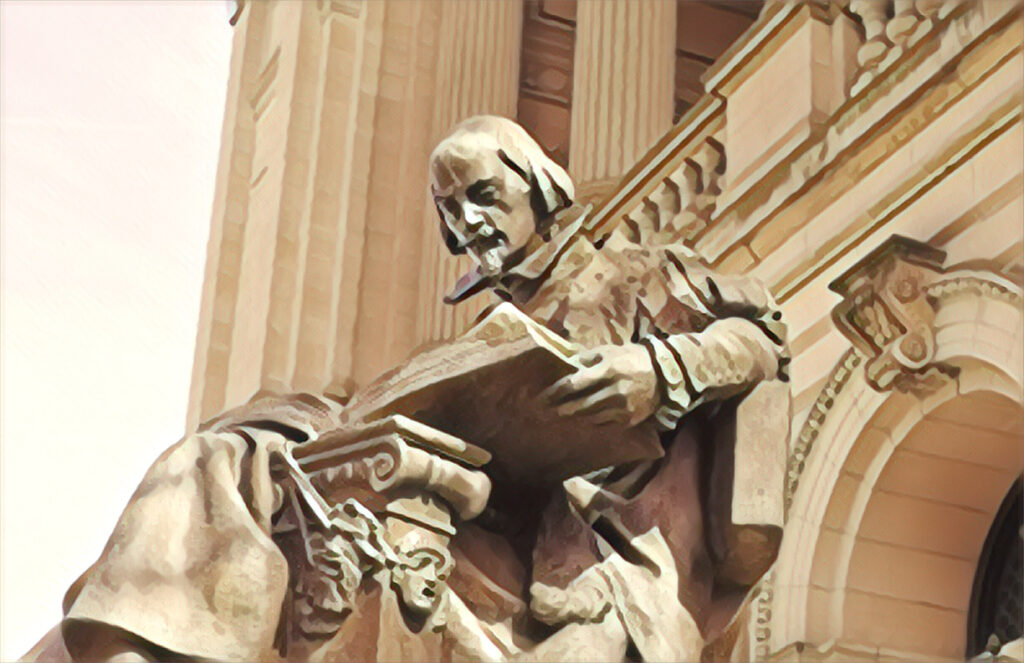
Here William Shakespeare is one of four larger than life sculptures–known as the Noble Quartet–that flank the entrances of the Carnegie Museum of Natural History in the Oakland neighborhood of Pittsburgh, PA.
The playwright appears so engrossed in the tome on his lap that he could not possibly care about the visitors entering the museum’s Music Hall entrance along Forbes Avenue. He’s representing the field of literature alongside Michelangelo (art), Bach (music), and Galileo (science).
Andrew Carnegie enlisted friend and fellow Scottsman, J. Massey Rhind to sculpt these for the museum along with the four allegorical muses sitting higher above on the roof. Rhind had quite a career as a sculptor.
Other notable works of his include the marble statue of Dr. Crawford W. Long inside Statuary Hall in the U.S. Capitol, four Union generals on the battlefield of Gettysburg, the Grand Army of the Republic Memorial in Washington, DC as well as numerous other statues and fountains found on the east side of the Mississippi River in the United States.
The Carnegie Museum of Natural History is located at 4400 Forbes Ave., Pittsburgh, PA 15213. It’s free to visit the statue on the exterior of the building though the museum has ticketed admission; prices vary.
Shakespeare Statue in the Reading Room of the Library of Congress
Washington, DC
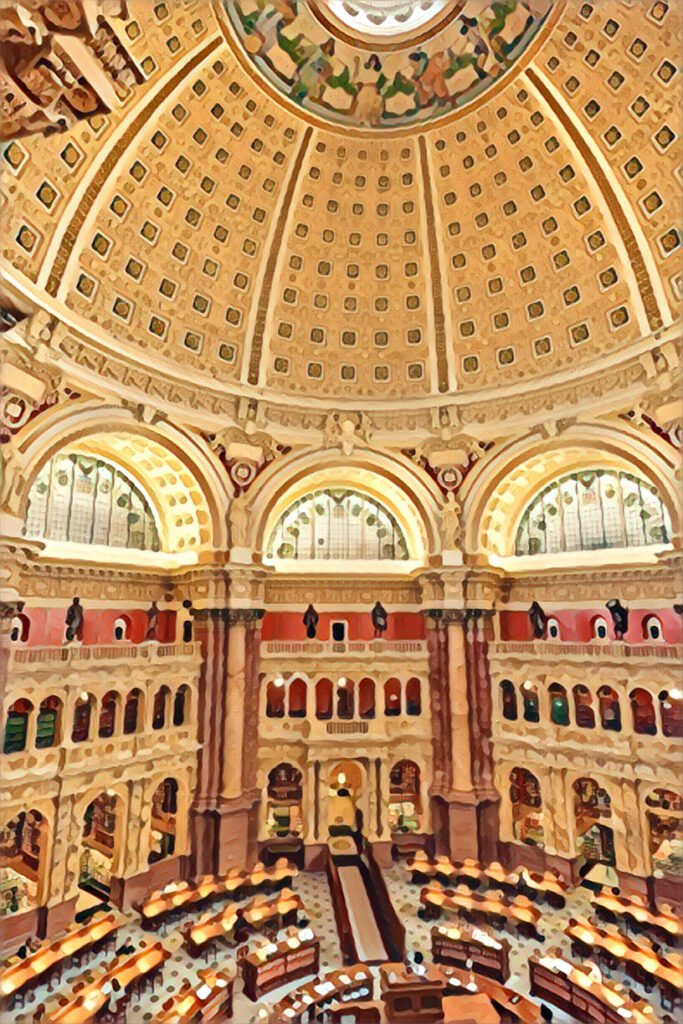
Overlooking the Main Reading Room of the Library of Congress’s visitor’s mezzanine, there are eight statues above each of the large marble columns surrounding the room. Each of these represent categories of knowledge–philosophy, art, history, etc. Below and between each of these statues of knowledge are two bronze figures representing specific men who excelled in the field. For the category of poetry, Ainsworth Rand Spofford (Librarian of Congress 1864-1897) chose Homer and William Shakespeare.
The Shakespeare bronze was created by sculptor, painter, and portraitist Fredrick William Macmonnies who was probably best known for this Nathan Hale statue that sits within City Hall Park in New York City near the location where the Revolutionary War hero was executed by the British. Smaller versions of the Hale statue can be found in art museums throughout the country.
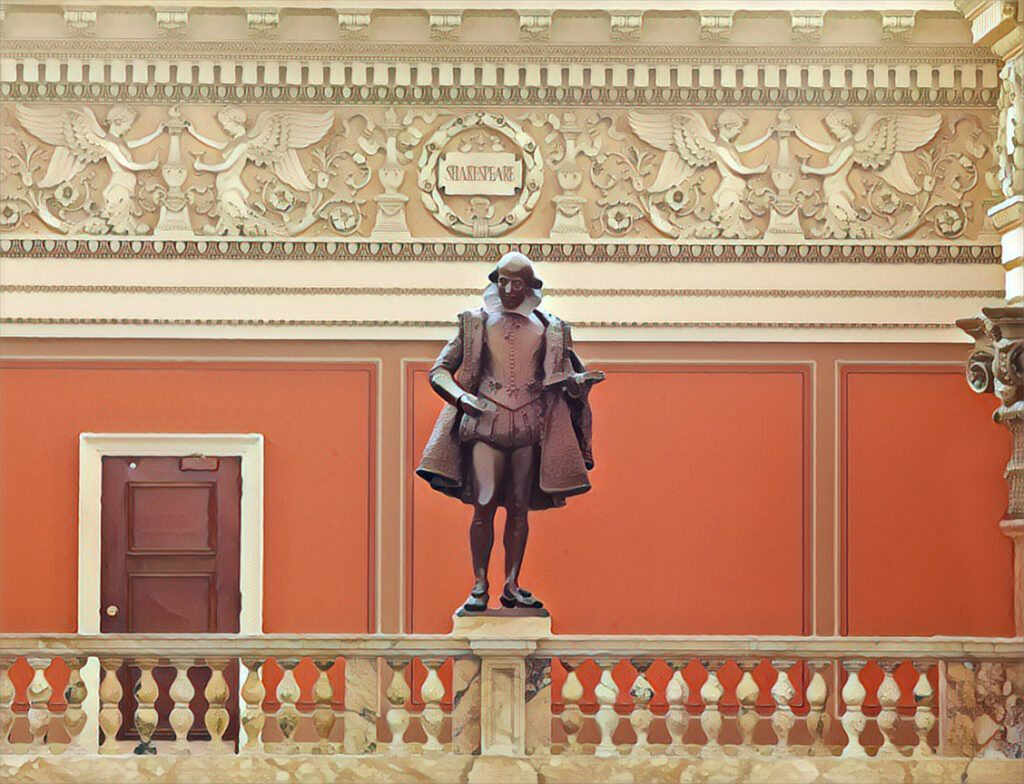
Other major commissions of Macmonnies include the Columbian Fountain which was a focal point of the 1893 Columbian Exposition in Chicago, the spandrel reliefs on the Washington Square Arch in New York City, and the bronze sculpture of Bacchante and Infant Faun now residing in the Metropolitan Museum of Art.
The Library of Congress is located at 101 Independence Ave. SE, Washington, DC 20540. Free timed-entry passes are required for your visit. The library is open Tuesday-Saturday from 10am-5pm with extended hours until 8pm on Thursdays.
Shakespeare Memorial in Logan Circle
Philadelphia, PA
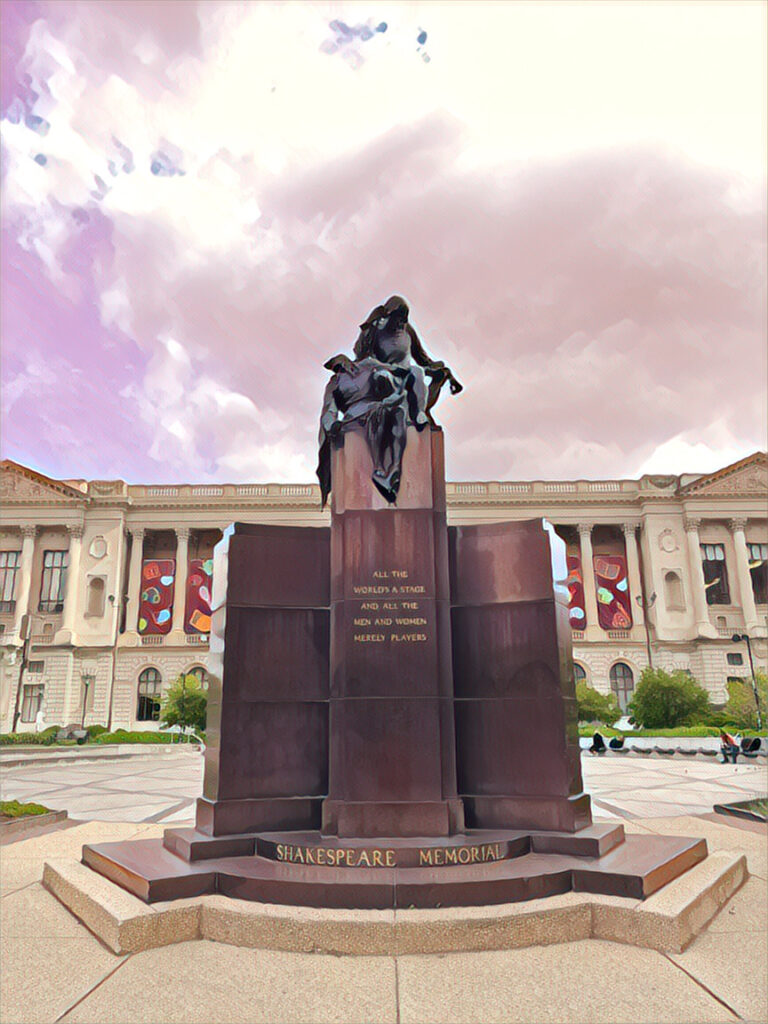
Tragedy and Comedy come together at this Shakespeare memorial that sits on Logan Circle (also known as Logan Square) outside the Parkway Central Library. Though the memorial was dedicated in 1929 on the anniversary of Shakespeare’s supposed birthday, it was initially proposed as far back as 1892. By the time the world honored the tricentennial of Shakespeare’s death in 1916, Philadelphia was still without a memorial to the playwright.
The bronze sculpture was created by Alexander Stirling Calder who is best known for the Swann Memorial Fountain in Philadelphia and George Washington as President on the Washington Square Arch in New York City.
Hamlet, representing tragedy, holds a dagger while leaning over the comedic jester, Touchstone, who sits at Hamlet’s feet. His head is rolling back in laughter. Inscribed at the base is one of Shakespeare’s most memorable quotes from As You Like It: “All the world’s a stage and all the men and women merely players.” How have you taken the stage?
Logan Circle is located at 200 N 19th Street, Philadelphia, PA 19103.
William Shakespeare Monument
Lincoln Park West, Chicago, IL
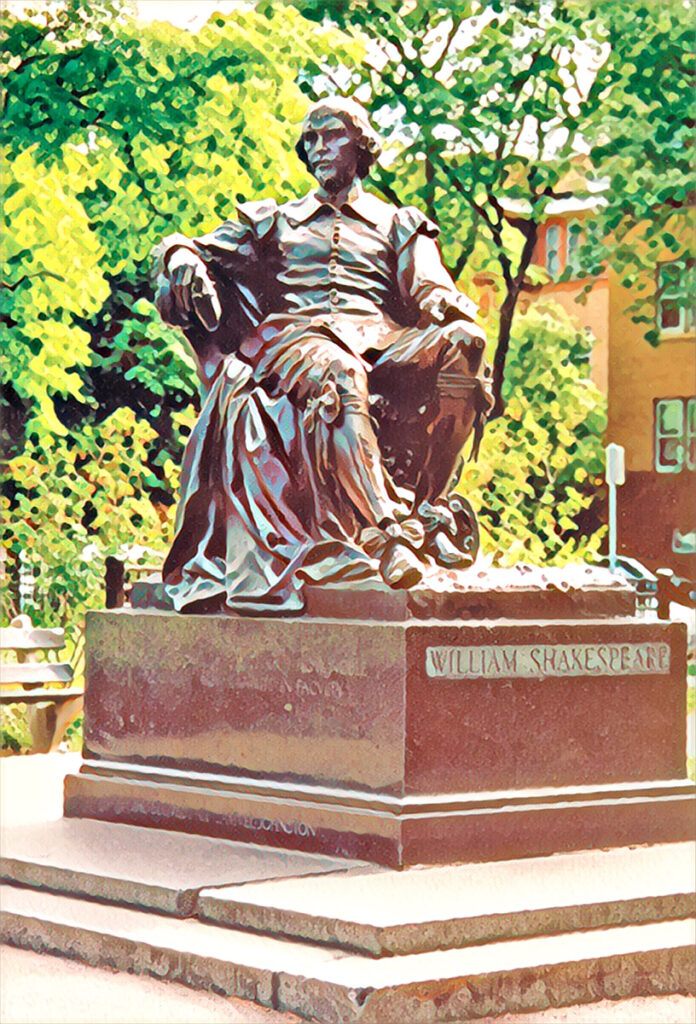
Upon his death in 1886, northside businessman, Samuel Johnston, left a sizable amount of money to be used for a Shakespeare memorial in Lincoln Park. As was common during the time, a national competition was held to choose who would sculpt the memorial. The winner was a then unknown artist, William Ordway Partridge, who had studied in France and Italy and had a brief stint as a student at Columbia University.
Partridge traveled to England to deeply study the likes of Shakespeare through artwork and even an inauthentic death mask before beginning on his sculpture. The plaster model of the sculpture was put on display at the 1893 Columbian Exposition in Chicago before the final bronze version was cast in Paris. The monument was unveiled on April 23, 1894 to commemorate Shakespeare’s death (and presumed birth).
Partridge would go on to sculpt some significant works including Pietá at St. Patrick’s Cathedral in New York City, a bas-relief memorial tablet for the gravesite of James Smithson, founder of the Smithsonian Institute, the Joseph Pulitzer Memorial in Woodlawn Cemetery, New York City, and Pocahontas in Jamestown, VA.
The William Shakespeare Monument is located at 2045 N Lincoln Park West, Chicago, IL 60614
Wynton M. Blount Cultural Park
Montgomery, AL
Alabama born, Wynton M. Blount, was a construction magnate (he started Blount International with his brother and worked on such projects like complex 39A at Cape Canaveral which launched Apollo 11 and the Louisiana Superdome) and U.S. Postmaster General under Richard Nixon. He also thrived in philanthropy. Along with his wife, Carolyn, the Blounts founded the Blount Cultural Park in Montgomery.
Reminiscent of the English countryside, the park is home to the Alabama Shakespeare Festival, a beautiful Shakespeare Garden containing horticulture that were referenced by Shakespeare in his writings, and the Montgomery Museum of Fine Arts as well as numerous walking paths and trails.
The Blounts donated all of the land and $21.5 million dollars in 1985 for a 100,000 square foot theater–which at the time was the largest donation to an American theater in history. Today, the Alabama Shakespeare Festival is one of ten largest in the world and stages more than 400 performances annually. Look out for the 1986 replica of the John Quincy Adams Ward Shakespeare statue in front of the theater.
Blount Cultural Park is located at 1 Festival Dr., Montgomery, AL 36117. The park is free to visit and the Shakespeare Garden is open seven days a week from dawn until dusk.
Oregon Shakespeare Festival
Ashland, OR
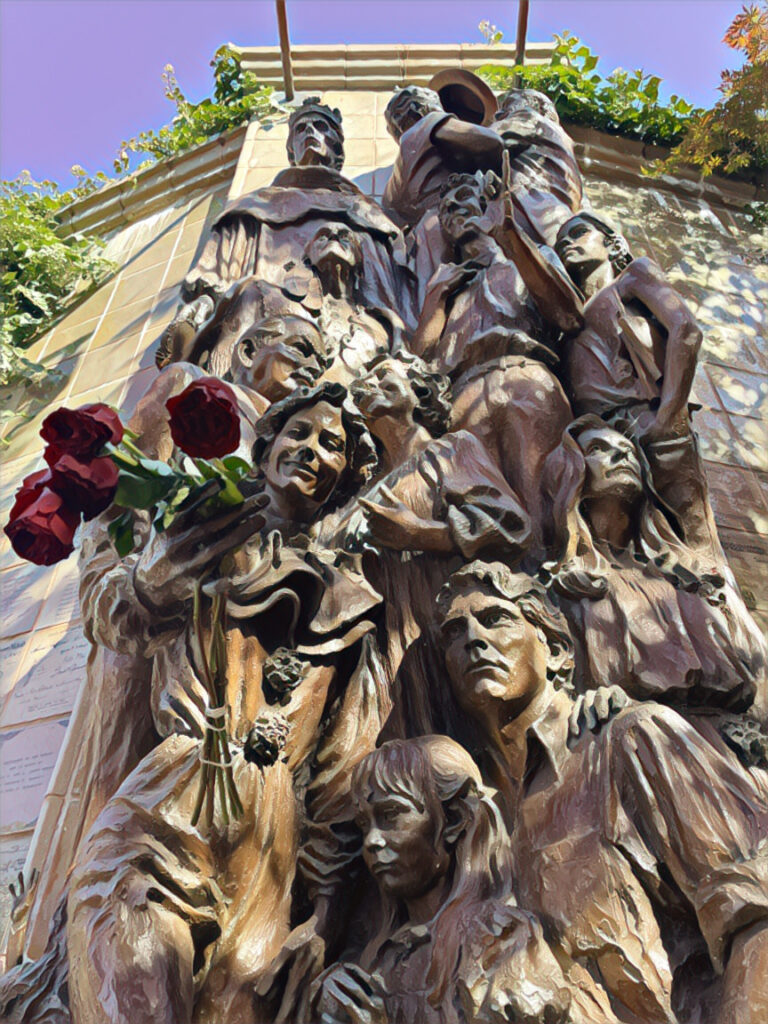
There are dozens of Shakespeare festivals each year in the U.S. but I’d like to argue that the Oregon Shakespeare Festival in Ashland is a bucket list adventure. The festival has been producing performances since the summer of 1935 when Twelfth Night and The Merchant of Venice were performed over the 4th of July holiday.
The festival may have never began if it weren’t for the popular cultural Chautauqua movement of the early 20th century. Ashland’s first Chautauqua building was erected in 1893 and expanded in 1905. Families traveled from all over the region to see performances by the likes of William Jennings Bryant and John Phillip Sousa.
Riding the Chautauqua momentum, a new structure–round with two domed roofs–was built in 1917 but unfortunately the movement dissolved in the early 1920s and the building fell into disrepair. The dome was removed in 1933 and all that was left standing were the cement walls surrounding the Elizabethan theater. Enter Angus L. Bowmer, a teacher from Southern Oregon Normal School (presently Southern Oregon University) suggested using the space to produce a festival.
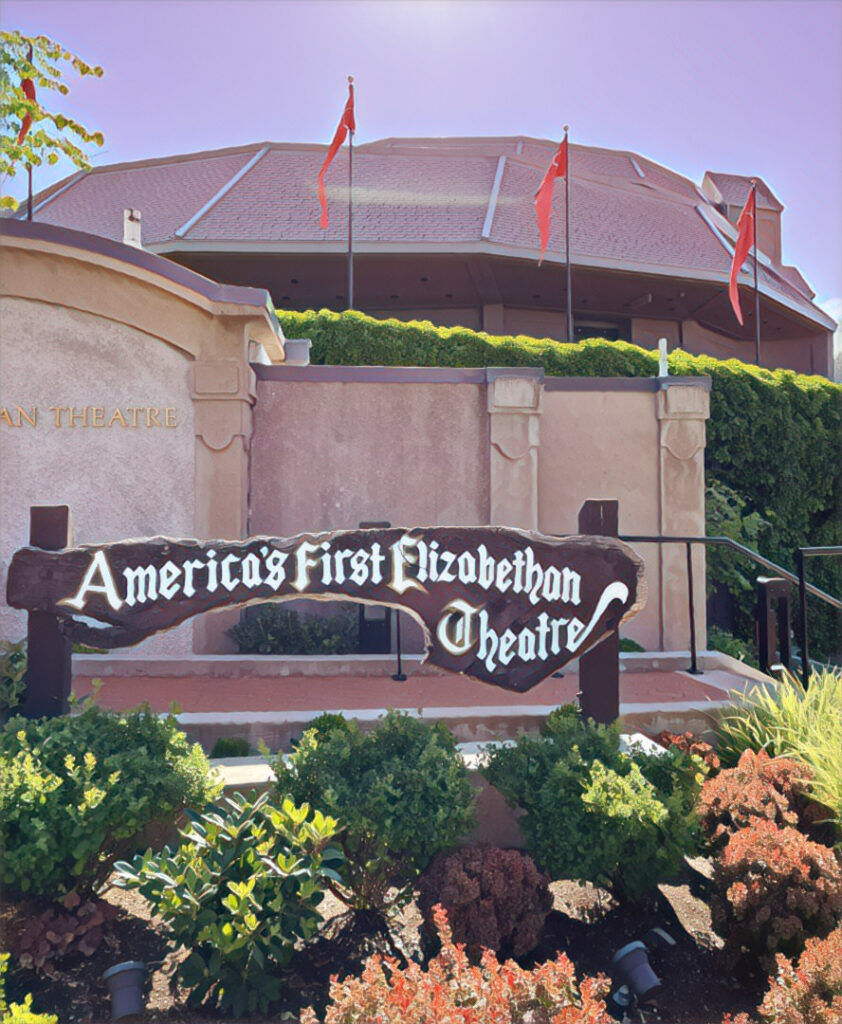
Since then, the festival has seen over 20 million visitors. During its season from April to December each year, the nonprofit organization holds between five and eleven performances across three stages six days a week. Additionally, from June-September, Wednesday through Saturday evenings offer a free “Green Show”. These feature a variety of performances including musical and dance groups, are family-friendly, and draw hundreds of audience members.
BONUS: For the best performances of Shakespeare plays, make sure to see offerings by the Shakespeare Tavern Playhouse in Atlanta, GA, the Chicago Shakespeare Theater, The Shakespeare Theatre Company in Washington, DC, and visit The Stratford Festival of Canada–home of the largest repertory theater in North America.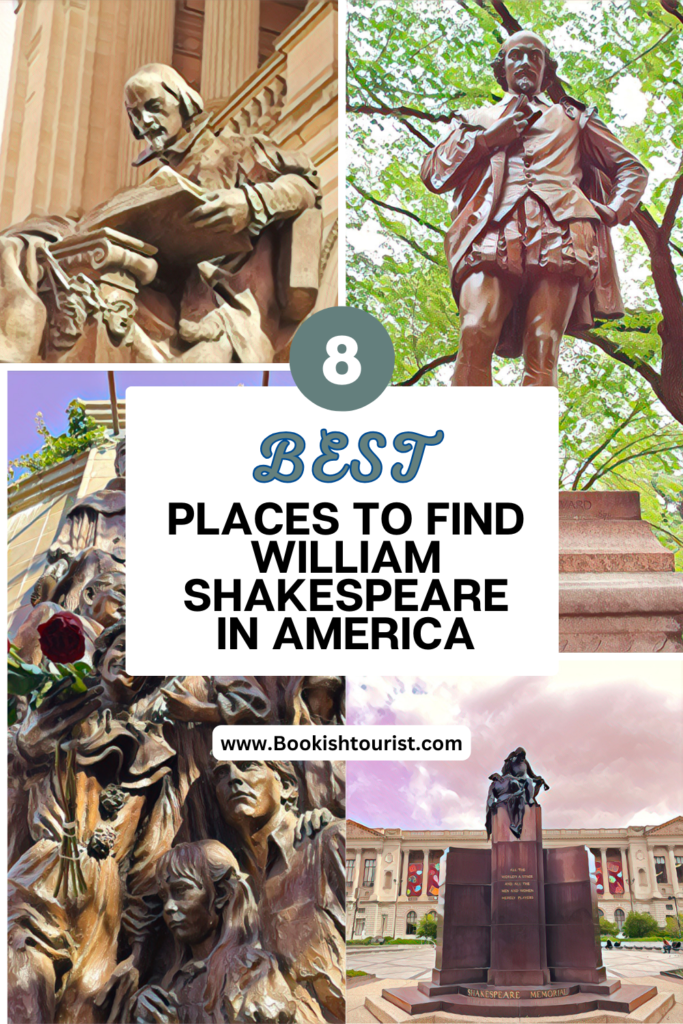
Those are the 8 best places to find William Shakespeare in America! Did we miss something major? Let us know in the comments.
